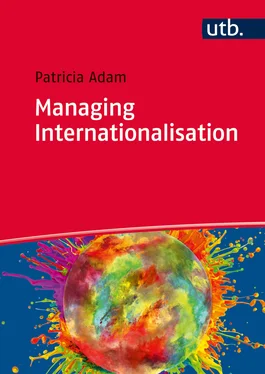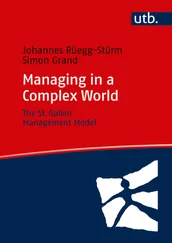When an organisation pursues a transnational strategy, decisions become far more complex, as multiple market requirements and the needs and capabilities of many different subsidiaries have to be taken into account and balanced out. In addition to that, non-business matters or soft factors require more management attention, especially the need for productive and harmonious cross-border relationships despite cultural differences and language barriers. Whereas the challenges presented by strategic, organisational and operational matters are anticipated and considered, corresponding soft factors are regularly ignored. A global survey of 572 executives explored internationalisation challenges and especially the role of cross-border collaboration and communication. More than 50 % of the respondents rated cross-border collaboration as very important, not only with all kinds of external partners but also within their business unit and their whole organisation. 64% reported cross-border collaboration as having been a critical factor in performance improvement. Despite its relevance, 51% admitted that linguistic and cultural diversity make it very difficult. Communication misunderstandings were reported to have stood in the way of establishing major cross-border transactions several times (6%) or a few times (43%) with incurred financial setbacks. Interestingly, due to a generally enhanced command of English, the diversity of languages across countries is no longer seen as the crucial cause for misunderstandings (only 27% reported this as most likely reason), instead different norms of workplace behaviour (49%) and differences in cultural traditions (51%) constitute the main challenges. Factors such as local customs and languages were stated to hamper their company’s international expansion plans significantly, especially in Russia (89%), Spain (88%), Brazil (70%) and China (67%). 14
In summary, dealing competently with intercultural issues constitutes one of the most important factors for a successful internationalisation. The basics of cross-cultural competence will therefore be addressed in detail in chapter 2 which is dedicated to this key issue.
VIPs

| 1.2 |
The Use of Holistic Management Models |
Managing any kind of organisation is a complex process and is made even more complex in an international and therefore usually unknown environment. The smaller and the more focused an organisation is, the easier it is for its (top) managers to rely on their experience and instincts for good management decisions. Consequently, the more an organisation is diversified, the more people are contributing to its success and the more it is dispersed over different locations, the more a clear structure is needed in order to not involuntarily overlook important matters.
Holistic management models were developed to ensure a balanced and complete view on all management matters of different types of organisations. They provide generalised issues that have to be solved in order to steer an organisation effectively to longterm success. These models are used for guidance in the management process, for assessing the maturity of an organisation’s management system and for electing the best organisations at quality or excellence price competitions.
Since the 1970s several holistic management models were published. To date, there are three models with international relevance: the (New) St. Galler Management Model, the model of the Baldrige Excellence Program and the EFQM Excellence Model.
The New Management Model is an integrative framework that provides a system-oriented view of a company and is edited by the Management Institute St. Gallen. It therefore presents predominantly a scientific view. The distinctive graphic as presented in Figure 1-5shows the company as a productive system in the centre of its surrounding network. It consists of six essential concepts: environmental spheres, stakeholders, interaction issues, structuring forces, processes and modes of development. These depict central dimensions of the management function. Whereas environmental spheres and stakeholder expectations have to be analysed with regard to important changes, interaction issues combine manageable matters concerning communication and resource allocation. Structuring forces should be set up to arrange the daily routines coherently, forming the company’s framework for value creating and other activities that are logically combined to consistent processes. Modes of development explain basic patterns of entrepreneurial change processes. The main aim of the St. Galler model is to support sustainable business solutions and organisational development. The University of St. Gallen uses this model as a basic guideline for executive management studies. 16

Figure 1-5: Survey of the New St. Gallen Management Model 15
The National Institute of Standards and Technology (NIST) is an agency of the U.S. Department of Commerce. It promotes U.S. innovation and industrial competitiveness by advancing measurement science, technology and standards with the help of cooperative programs. The Baldrige Performance Excellence Program is one of those. Driven by a more practical need, criteria were developed in order to evaluate organisations and their competitiveness and to provide guidelines for organisational improvement. The Baldrige criteria and their systems perspective are used for assessing the applications for the Malcolm Baldrige National Quality Award (MBNQA) that is awarded yearly by the U.S. president. 17
The requirements of the Baldrige Criteria for Performance Excellence for business and non-profit organisations are embodied in seven categories, as shown in Figure 1-6. These categories are integrated and connected in the Baldrige framework or systems perspective. Its top basic element is the “Organizational Profile”. It sets the context for the way an organisation operates as it includes its competitive environment, relationships and its strategic situation. Core values and concepts form the basis for the actual Performance Management System. This is first composed of six Baldrige categories: the leadership triad with Leadership (category 1), Strategy (category 2), and Customers (category 3) which sets the organisational direction, and the results triad with Workforce (category 5), Operations (category 6) and Results (category 7). All actions taken by the organisation’s workforce and key operational processes produce its overall performance results. The seventh category forms the system’s foundation, as Measurement, Analysis, and Knowledge Management (category 4) are critical to a factbased, knowledge-driven and effective management system. The central part “integration” stresses the model’s holistic and integrated perspective. The criteria categories are subdivided into overall 17 process and results items, each focusing on a major requirement. Each item consists of one or more areas to address that define more specific requirements. This third level of the whole model is the level that organisations should address in order to explain their particular solutions and approaches when applying for the MBNQA. 18

Figure 1-6: Baldrige Criteria for Performance Excellence Framework 2015 19
Читать дальше















